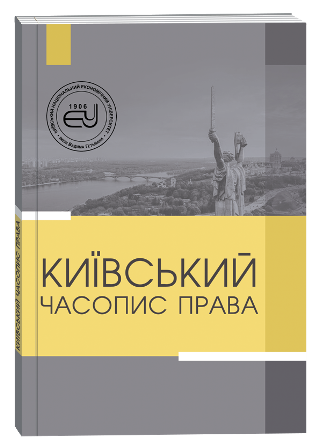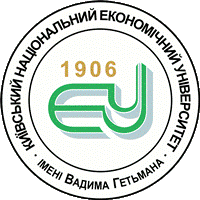SYSTEMATICITY AS A PROPERTY OF THE CONTENT OF LEGISLATION
DOI:
https://doi.org/10.32782/klj/2022.1.7Keywords:
legislation, content of legislation, form of legislation, systematicity of legislation, orderliness (systematics) of legislationAbstract
Abstract. In this scientific article the meaning of the concept of “systematicity of legislation”, which is used in legal science to characterize the organization of legislation, in its relation to the concept of “orderliness (systematics) of legislation”, is clarified. It is argued that the understanding of the terms “systematicity” and “orderliness” is associated with keywords such as “system” and “order”, respectively, that reflect their conceptual meaning. The main features of the system are structure, interrelation of the constituent elements of the system with each other and integrity, and the order is characterized by compliance with the state of the object to certain requirements, rules, norms, standards and more. It is noted that legislation, like any other phenomenon, is revealed, in particular, through such paired categories of dialectics as content and form, and therefore such properties of legislation as systematicity and orderliness should be considered not in relation to the legislation in general, but in relation to its content and / or form. It is claimed that the content of the legislation is a system of legal norms enshrined in normative-legal acts of public authorities and their officials, and the form is a hierarchical set of normative-legal acts of public authorities and their officials, in which these legal norms are given textual expression, and the form of which is clearly defined by the Constitution and laws of Ukraine. It is argued that systematicity of legislation should be considered as a property of the content of legislation, which is that legislation is a form of external expression of the legal norms organized by branches and institutions of legislation. Since the system of law (as a set of legal norms, united in the branches and institutions of law) is the substantive basis of legislation, the legislation as one of the forms of external expression of legal norms systematically organizes their content. Regarding the concept of orderliness (systematics) of legislation, it is noted, that in the form of legislation, as a hierarchical subordination of normative-legal acts of public authorities of different legal force, there must be a certain order, its components (normative-legal acts and their structural elements) must be organized in compliance with relevant requirements, rules, standards, norms, etc. It is pointed that the main methods of rule-making techniques, that ensure the systematicity of legislation in the process of rule-making activities of public authorities, are normative structure, legal construction and branch typification. The method of normative structure is connected with the external expression in the legislation of the full structure (hypotheses, dispositions and sanctions) of the legal norm. The method of legal constructions should ensure the construction of a particular institution of legislation on the basis of the relevant institution of law as a set of objectively necessary orderly and interrelated normative-legal regulations. The method of branch typification provides construction of the branch of the legislation on the basis of the corresponding branch of law.
References
Луцький Р. П. Позитивне право як баланс раціонального співвідношення державної волі та волі громадян. Науково-інформаційний вісник Івано-Франківського університету права імені Короля Данила Галицького. 2014. № 10. С. 26-31.
Великий тлумачний словник сучасної української мови (з дод. і допов.) / Уклад. і голов. ред. В.Т. Бусел. К.; Ірпінь: ВТФ «Перун», 2005. 1728 с.
Подковенко Т.О. Система законодавства України: стан та шляхи вдосконалення. Підприємництво, господарство і право. 2005. № 9. С. 40-44.
Загальна теорія права. Нормативний курс: підруч. для студ.-юристів / За ред. д-ра юрид. наук, проф. С.В. Бобровник. Київ: Юрінком Інтер, 2021. 596 с.
Дашковська О.Р. Системність законодавства як його конститутивна ознака. Науковий вісник Міжнародного гуманітарного університету. Серія: Юриспруденція. 2013. Вип. 6-2(1). С. 34-37.
Суходубова І. В. Системні властивості законодавства та його співвідношення із системою права. Економічна теорія та право. 2015. № 1 (20). С. 268–279.
Теорiя держави i права: пiдручник / О.В. Петришин, С.П. Погребняк, В.С. Смородинський та iн.; за ред. О.В. Петришина. Х.: Право, 2015. 368 с.
Погребняк С.П. Колізії у законодавстві України та шляхи їх переборення: автореф. дис... канд. юрид. наук: 12.00.01 / Нац. юрид. акад. України ім. Я. Мудрого. X., 2001. 19 с.
Чухвичев Д. В., Аширов Б.С. Законодательная техника: учебное пособие / Центр ОБСЕ в Ашхабаде. Ашхабад, 2011. 316 с.
Теория государства и права: Курс лекций / Под ред. Н.И. Матузова, А.В. Малько. 2-е изд., перераб. и доп. М.: Юристъ, 2001. 776 с.
Кухарук Т.В. Правовая система и систематика законодательства: дис. ... канд. юрид. наук: 12.00.01: СПб., 1998. 233 c. URL: http://www.dslib.net/teoria-prava/pravovaja-sistema-i-sistematika-zakonodatelstva.html (дата обращения: 01.04.2021).
Риндюк В.І. Упорядкування законодавства України: теоретико–методологічний та техніко-юридичний аспекти: монографія. К. КНЕУ, 2021. 407 с.
Іванченко О.П. Систематизація законодавства: науковий вектор, практичні потреби. Часопис Київського університету права. 2015. № 3. С. 53–56.
Кононюк А.Е. Системология. Общая теория систем. В 4–х кн. Кн 1. К.: Освіта України. 2014. 564 с.
Тарнавська Т.В. Генеза поняття «система»: історичний огляд. Духовність особистості: методологія, теорія і практика. 2011. № 6 (47). С. 129–139.
Ожегов С.И. Словарь русского языка: Ок. 57000 слов / Под ред. Н.Ю. Шведовой. 16-е изд., испр. М.: «Русский язык», 1984. 797 с.
Словник української мови в 11 томах виданий в 1970-1980 роках. URL: http://sum.in.ua/ (дата звернення: 30.03.2021).
Конверський А.Є. Логіка: підручник. 2‐ге вид., виправлене. К.: ВПЦ «Київський університет», 2017. 391 с.
Рабінович П.М. Система права – об’єктивна основа систематизації законодавства (гносеологічний аспект). Систематизація законодавства в Україні: проблеми теорії і практики. Матеріали міжнародної науково-практичної конференції. К., 1999. С. 79-82.
Ющик А.И. Диалектика права. Кн. 1: Общее учение о праве (Критический анализ общеправовых понятий). Ч. ІІ. К.: Ред. журн. «Право Украины»; Ін Юре, 2013. 768 с.
Риндюк В.І. Упорядкування законодавства України (теоретико-методологічний та техніко-юридичний аспекти): автореф. дис. … доктора юридичних наук / Ін-т держави і права імені В.М. Корецького НАН України. К., 2021. 44 с.
Биля-Сабадаш І.О. Нормотворча техніка як інструмент забезпечення системності законодавства. Форум права. 2010. № 1. С. 24-33.
Биля-Сабадаш І.О. Галузева типізація у правовому регулюванні суспільних відносин. Права людини і демократія: зб. наук. ст. за матеріалами наук. конф., м. Харків, 15 трав. 2018 р. Харків, 2018. С. 3–8.







